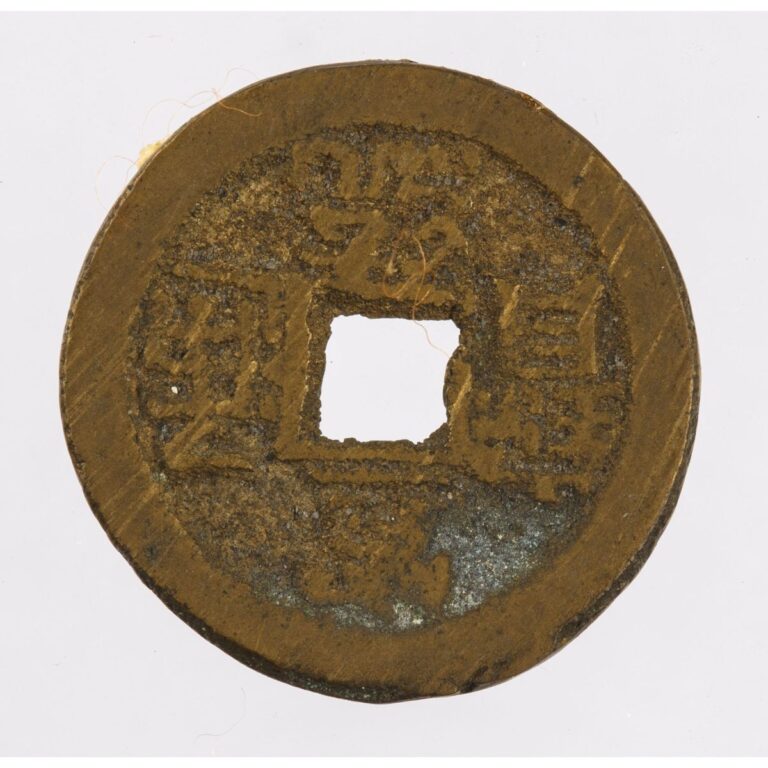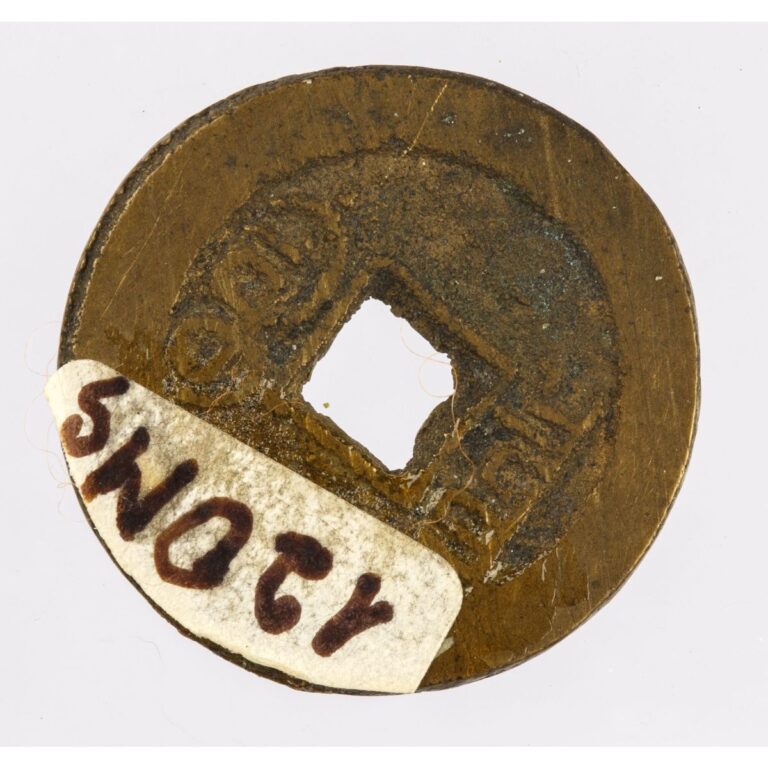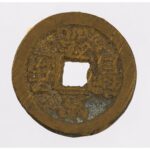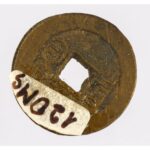Coin Xuantong tongbao
A round copper alloy coin with a square hole in the centre, called fangkong qian 方孔錢. These appeared in various denominations, mostly as tongbao 通寶 (“ordinary currency”) coins, which were worth one monetary unit, and yuanbao 元寶 (“original currency”) and zhongbao 重寶 (“heavy currency”), which had a higher face value. Such coins were in circulation as standard money, in many varieties and denominations, from the time of Emperor Gaozu 高祖 (reigned 618–626), first emperor of the Tang Dynasty (618–907), until the end of the Qing Dynasty (1644–1912). The inscription on the coin usually consists of two characters, reading from top to bottom, indicating the name of the imperial reign or the single reign period (nianhao 年號) in which the coin was minted. The other two characters are read from right to left. On the left-hand side of the coin, we always find the character bao 寶 ... more
A round copper alloy coin with a square hole in the centre, called fangkong qian 方孔錢. These appeared in various denominations, mostly as tongbao 通寶 (“ordinary currency”) coins, which were worth one monetary unit, and yuanbao 元寶 (“original currency”) and zhongbao 重寶 (“heavy currency”), which had a higher face value. Such coins were in circulation as standard money, in many varieties and denominations, from the time of Emperor Gaozu 高祖 (reigned 618–626), first emperor of the Tang Dynasty (618–907), until the end of the Qing Dynasty (1644–1912). The inscription on the coin usually consists of two characters, reading from top to bottom, indicating the name of the imperial reign or the single reign period (nianhao 年號) in which the coin was minted. The other two characters are read from right to left. On the left-hand side of the coin, we always find the character bao 寶 (wealth, preciousness), which in combination with the character on the right means “currency” or “money in circulation”. This is most often the character tong 通 (circulate, be uniform, general, or universal), but often it is also yuan 元 (original) or zhong 重 (weight), which usually denote coins with a larger face value. Thus, the entire inscription literally means “money in circulation during the time of this or that emperor” or “during this or that period of the reign of a single emperor”. Coins from the time of the last, Manchu Qing dynasty have, in addition to the inscription in four Chinese characters on the obverse, an inscription on the reverse, usually indicating the location of the mint. It was originally written in Chinese, then in Chinese and Manchu, and finally only in Manchu.
The coin in the image is relatively well preserved, so the characters on the obverse, Xuantong tongbao 宣統通寶, can be easily read, which means it was minted during the reign of Xuantong 宣統 (1908–1912), the last emperor of China, who ascended the throne at the age of three and is better known in history by his personal name, Puyi 溥儀 (1906–1967). Even during Xuantong’s short reign, traditional round coins with a square hole in the centre were still minted, although copper coins minted using Western techniques were also widely used at this time. The traditional coins were primarily minted in Beijing, but a few mints in various provinces remained active during these years. At the end of the Qing Dynasty, coins were much smaller, thinner, and of poorer quality than those minted in the early days of the dynasty, due to the numerous economic constraints faced by the declining empire. The inscription on the reverse of the coin is written entirely in Manchu script, but due to the poor condition of the coin it is indistinct. On the left is written from top to bottom boo ᠪᠣᠣ, which is a phonetic transcription of the Chinese bao meaning “money”, “treasure”, or “currency”, while on the right-hand side is the Manchu inscription ciowan ᠴᡳᠣᠸᠠᠨ, a phonetic transcription of the Chinese term quan 泉 meaning “source”. The full spelling, boo ciowan ᠪᠣᠣ ᠴᡳᠣᠸᠠᠨ, is a Manchu phonetic approximation of the Chinese term baoquan 寶泉, meaning “source of wealth”, and indicates that the coin was minted at a mint under the administration and supervision of the Bureau of Revenue (Hubu 戶部) in Beijing. (MG)







































Do you have a comment or additional information about the subject?